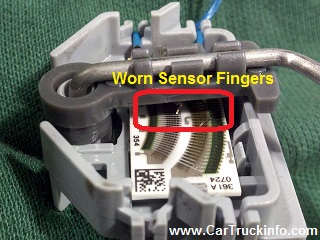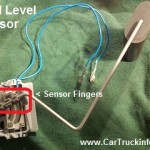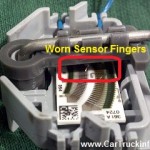One thing I see and hear quite a bit of from customers is that they complain that their fuel gauge is inaccurate or acts very erratically. I’ve been dealing with these type of problems since I got into the business almost two decades ago. The one common factor in most of these complaints is the fuel level sensor.
Late model fuel injected cars and trucks all have their fuel pumps located in the gas tank. There is also a fuel level sensor, or you may know it better as a ‘sender’. It holds the float assembly along with a resistor board that has small little metal ‘fingers’ that touch the board and send the signal to the fuel gauge to display the proper amount of fuel in the tank. What happens when the fuel gauge becomes erratic is that the little metal ‘fingers’ start to deteriorate from fuel additives, corrosion and just plain bad gas.
Now, once there is any type of gap from a small amount of corrosion, these fingers start to touch the resistor board less and less which will send the wrong signal to the fuel gauge. Once this starts to get worse, there will be portions of the fingers that are barely touching and others that are kind of flopping on and off the board. This will send the crazy signal to the fuel gauge. This would be the time you see the gauge going from full to empty on it’s own, or usually after you fill up your vehicle it will act up from the sloshing around of the gasoline.
This can get quite annoying, and will leave you not knowing how much fuel you actually have. These are the times people run out gas because the gauge showed more fuel than they had. Usually now is when they bring it in to the shop!
I’ve replaced hundreds of these fuel level sensors, and every time I take one off I inspect the float arm and resistor board and metal fingers. Every single time, I can physically see the deterioration of the metal. Customers are especially happy to see this so they know what was causing their problem. Repairs like this aren’t usually cheap. Fuel level sensors on newer cars are usually 100 – 200 dollars just for the part, plus usually two to three hours labor depending on the vehicle, sometimes more.
Getting this diagnosed is fairly easy. Just about every mechanic has seen this type of problem. Late model GM vehicles will usually set a trouble code for the fuel level sensor when there is a problem with it. If your car has a code for this, you definitely need a new sensor.
The only bad thing is, there is really no way to completely stop this from happening. Running a good quality gasoline definitely helps and prolongs the life of fuel system components. Just keep in mind when you see your fuel gauge acting funny, get it checked out! You don’t want to be left on the side of the road, alone, and out of gas!
- Picture of the gas gauge sending unit inside the fuel tank.
Live Chat
I’m looking for the location of a sensor on or near the gas tank. Fuel pressure sensor? It is a 2001 Pontiac Grand Prix.
ProTech:
Do you mean the fuel tank pressure sensor?
Unsure, but it sounds like it. Yes
I’m guessing you have a check engine light with a code related to the sensor?
Yes but i do not have that info with me.my ex says basically its the gas cap but that has been replaced.
OK. The fuel tank pressure sensor is located on top of the fuel pump assembly, on top of the gas tank. But without knowing the code, i would not just go and have that replaced. There are codes related the the system that can be another parts problem. Most of the time when people think a bad or loose gas cap has caused the engine light, the problem is usually what is called the “EVAP system Vent valve”.
He says that it might be a sensor. Where would i find this EVAP system vent valve?
That is located inside the drivers side rear wheel well. Again, the code number is the key to deciding what part has failed.
I will ask for the code and get back to you or some one else. thank you for your time. and know how.
Your welcome.
Leave comments below or see these




Leave A Comment, Reply Or Ask A Question
128 Comments on "My Gas Gauge Reads Empty When It Is Full Of Fuel"
My 2004 Chevy Classic’ s fuel gauge went down to empty and a red light came on. Gas tank is full. What can it be?
fuel level sensor problem a yr ago went away, returned w/ bad gas – must I replace?
Hello I have a 2012 Toyota Tundra with 133000
Miles on it.
My Low Fuel light is ON, but the Fuel in the Tank is Accurate.
And the Gauge shows Proper Fuel Level .
Do You Know what may be the Problem
Thank You in Advance.
1989 ford f-150 5.0 litre fuel line stuck on fuel injector rail. soaked in pb blaster and still won’t come apart. can’t afford to replace lines and rail,is there any other solution to this problem.
I was driving home and the screen on my left hanf side rrads..empty to range..300km..I am worried something went wrong because I have half a tank fuel..but dont know how much gas is left in the tank..thanks
The fuel sensor fingers come in two sets of three. Before installing my new pump one set of the sets broke, will it still monitor fuel levels with only one set of three fingers?
My 2011 Elantra is showing the fuel low icon but the gauge is 3/4 full. Just filled recently.
my Santa Fe 2001 the fuel Gauge Needle Doesn’t Go Back Down To Empty When Car Is Turned Off so is tihs problem or its going fine
Does my 2005 Pontiac Sunfire have what someone called a Sensor? (that I can go out and slap) Joke
I have a 2005 Pontiac Sunfire and the gas gauge is stuck on empty, matter of fact it is stuck next to the 100 number on how fast the car is going. I put gas in it to make sure I have enough in it and it is always full it only takes a couple of dollars. How do I get if fixed and where can it be taken? Is it considered an old car? I don’t know any thing about cars as you can tell. Oh please tell me you can help with this mess!!!
I have a 1994 Chevy Caprice my car was idling and all of a sudden start idling bad or gas hand shot up to full now every time I cut my lights on my car star running back and getting ready to cut off and start missing and stuff what could that be
Why isn’t there an aftermarket for the fuel cap with a tube which would mechanically measure the amount of fuel in the tank? Or is there?
Women. lolololo
Vw jetta3 carb.1.8.1993 ,happen just now and never before ,tank is full but gaugage
shows,half tank only,OK red some where fuel tank level asmb.on its way out,me query,can
some flexi line be pushed thru petrol cap,thin tube to thee tank to shows level of fuel
before properlyy fixed?
Just filled up my 07 f150 and needle only reads half full? Whats my problem?
A would I need a new flow for my 2002 Isuzu Axiom cause my gas hand keep saying empty when I fill it up or is it a sensor for it
Have 07 Chevy malibu. Replaced whole fuel pump assembly. Gage still going up and down,and check engine light on ,and off,please help.
My gas gauge is inaccurate, and the car is hard to start sometimes without giving it gas. I can smell gas when I start it sometimes too. Any ideas?
I replace my fuel pump in my 2006 Chevy Malibu now when we fill up our tank it reads empty when we are empty my gauge reads full what is the problem
Have 1996 dodge van 2500 . The gate reads full all the time .Replaced whole fuel pump . Gate still reads full . Whats my problem ?
I just got the fuel level sensor replaced on my ’08 Santa Fe today, but before I did the needle would move up and down. Now it only reads at 1/2 tank. Do i have to drive it around until it reads it correctly?
i have a 1994 gmc truck gas gauge reads on over the full mark and does not move
I have a 95 Dodge Dakota Sport 3.9L it acted like I ran out of gas while driving. Put 4 gallons in, no start. Got it home, verified that I did have good spark at plugs and coil, tried priming with gas, nothing. Let it sit for an hour. Tried starting fluid, nothing. Cleared OBD codes (only had codes for EGR valve) and cleaned battery terminals and cable ends before putting them back on. charged up battery and added 2 more gallons to tank. Checked for fuel pressure at fuel rail valve, positive. Waited 4 more hours and it began to start but acted flooded, it cleared and ran good. Took the truck on three test drives, ran good. BUT I filled it up and could only put 6.2 gallons in the tank?? I’m almost positive this truck has a 16 gallon tank. Any ideas what would cause it to “run out of gas” when there should have been 4 gallons in it?
My truck is 2500 4×4 dodge extended cab 5.9 Cummings it runs out at half a tank and gadget says 1/2 full
Thank you for the information, this really helped me out understanding my problem. Love this site.
I have a Yukon. I just filled it up and when I started it the gas gauge went to empty and low fuel light came on, but tank is full. Will I still be able to drive it until I can get it fixed or will it strand me??
You will be able to drive it just fine.
Fuel level sensor code came on my ford f150, had a new fuel pump and sensor installed and it still show low fuel, any suggestions
A shorted wire is possibly the problem.
Hi I just purchased a 2011 hyundai sonata and the gas gauge doesn’t tell me how much gas I have. The empty light keeps blinking..can it be the gas pump or sensor.. what can the approximate cost be for this?
Thank you
I have the same problem with mine since I purchased it back in July. I would like to know what it is and how much I’m looking at spending to get it fixed. Or is it included in the warranty that I have
2003 Saturn, L200, 2.2 L engine Service light is ON, Gas gauge shows empty but it isn’t, and Security light is ON. They didn’t come ON until I drove 20 miles down the road. What’s the problem?
Hello 2005 mustang. Had check engine light, Ford dealer read code as replace fuel pump, I did now fuel gage fluctuates from accurate to empty. When empty read the idle drops. Thanks
2004 ford explorer fuel Guage malfunctions does this mean that the fuel pump is going
No, the fuel level sensor is attached to the fuel pump assembly, but does not effect the pump at all.
I have an 08 Tahoe. We had our sensor changed (twice) and it is still not calculating the gas right. It will go from full to 1/2 in only a few miles or stay on full for a while then go right to half. My airbag light is on I was wondering if it may have something to do with the computer?